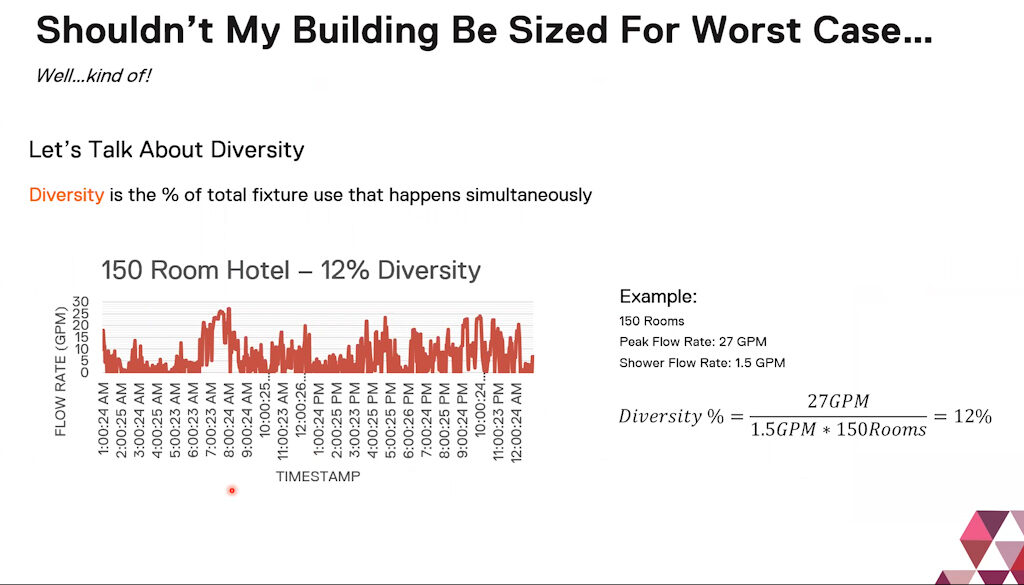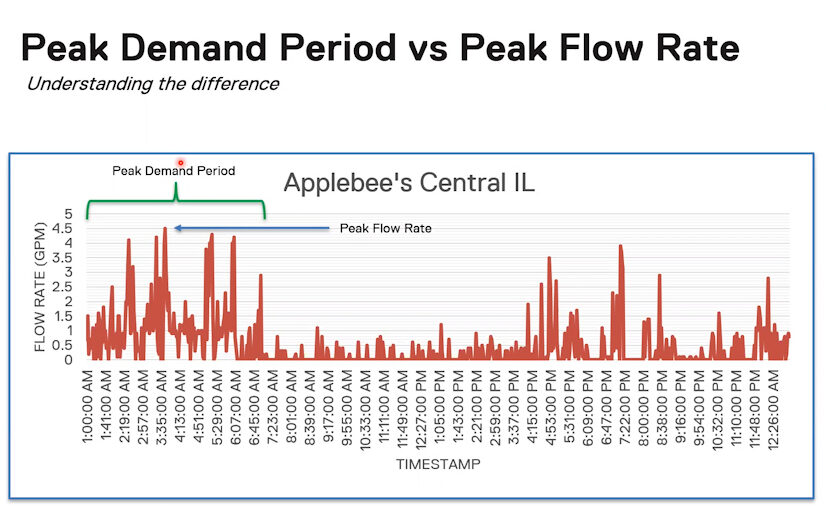Should you size your property’s water heating system for the worst case scenario?

Mechanical Engineer | Sales Engineering and Education Manager at Intellihot

So maybe the obvious question is, shouldn’t you be sizing a building for the absolute worst case scenario? And the answer to that is kind of yes, you should be sizing your building for the worst case scenario. The reason for the “kind of” is that often times, your worst case scenario isn’t quite what you think your worst case scenario is. And that introduces the concept of diversity.
So diversity, when we talk about building systems, refers to the percentage of total fixture use that happens simultaneously. So it’s easy to think about this in terms of a hotel. If I have 150 rooms in my hotel, that means I have 150 showers. And when we think about simultaneous usage, specifically for systems that are delivering hot water instantaneously, we have to size based on that instantaneous peak: that peak flow rate.
The distinction between peak demand period and peak flow rate is the period. The peak demand period is a length of time across which you have a whole bunch of water use. Your peak flow rate is an instantaneous phenomena. Peak flow rate is a single value. It is the fastest rate at which hot water is discharged.

And so in this case, peak flow rate is going to be somewhere around four and a half gallons per minute. Well, what diversity tells me is how many of those fixtures can I expect to have open at any given time. And this is an important question, because if that number is 50% or 70% or 80%, that’s going to be a much bigger piece of equipment than if that number is something like 15% or 10%.
This has a very large bearing on sizing. And it’s important to note that no matter which methodology you are using, every methodology makes an assumption about diversity. Nobody is sizing a system, expecting all of their fixtures to be open at the same time.
Your building systems aren’t even designed that way. It doesn’t happen. And sizing a system like that is going to be a tremendous waste of CapEx. Calculating diversity is relatively simple. Essentially, it’s just your peak flow rate, right?
What my peak flow rate condition is over the total probable use. So if I assume 1.5 GPM, 150 rooms, I can calculate my diversity here for this hotel. Now, it’s important to note that diversity changes both with building type and occupancy. Also, it changes with building size, building type, and occupancy.
So, for example, I have a 150 room hotel. I’m seeing 12% diversity on that system. This is all data that we have pulled from real world applications here. If I have an 84 room hotel, that has a 15% diversity factor.
Now, both of these hotels actually have similar occupancy levels. In other words, these readings were taken on weekends where I saw very close to my maximum occupancy. You’ll note that as I decrease the size of the hotel, my diversity factor goes up. And again, this is something that’s relatively intuitive, if you think about it. Let’s say I have a ten room hotel and I have one person showering. I’m already at 10% diversity.
As I increase the size of my hotel, it decreases the probability that I’m going to have simultaneous fixture use. So this is an important concept here. As the hotel gets smaller, my diversity factor goes up. It’s also the case that as I change my application type to FSR (full service restaurant), my diversity changes as well. So, a full service restaurant is going to have a higher diversity than my hotel does when I’m in my peak washing conditions.
Lunch & Learn for Engineers

Robbie Svidron,
Sales Engineering & Education Manager
B.S. in Mechanical Engineering
*We will send a DoorDash gift card for virtual meetings.

2900 W Main St.,
Galesburg, IL 61401
General: 1-877-835-1705
Product Support (24/7): 1-866-692-6791
